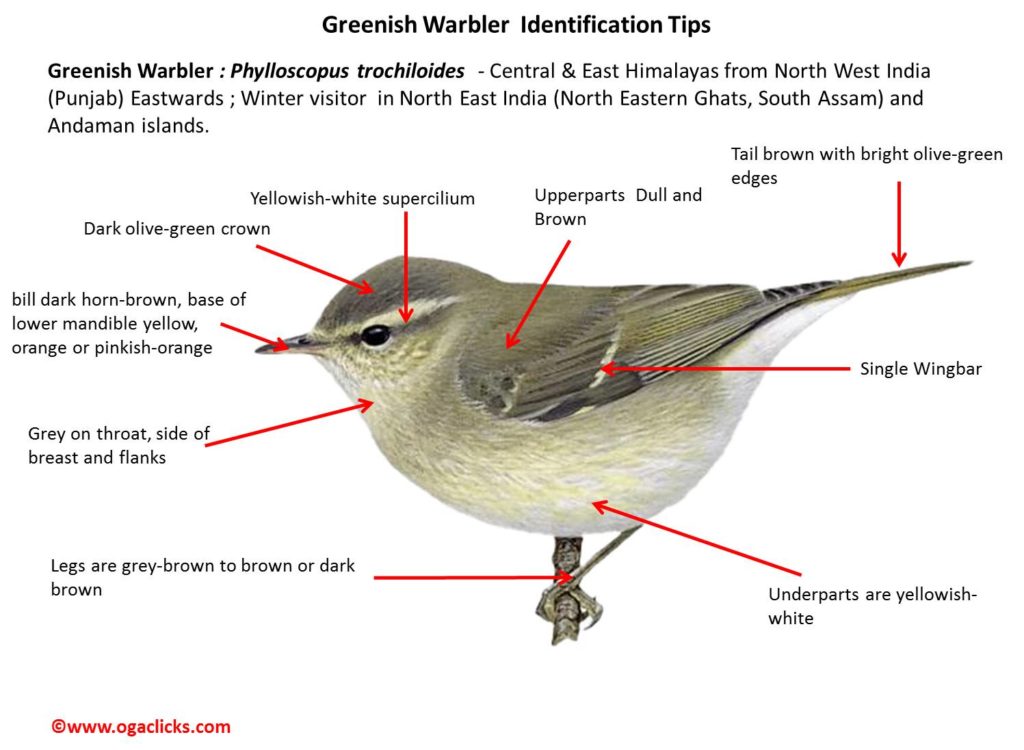Greenish Warbler

Greenish Warbler Phylloscopus trochiloides
Etymology:
- Phylloscopus : Greek word phullon – leaf; skopos–seeker
- Trochiloides : Greek word trokhalosbowed ; oidesresembling
Vernacular names :Pun: Haripiddi, Naga: Inruite, Guj: Lilashvalokitkit, Lilokitkit, Jhankhilili futki, Mar: Hirvat Vatvatya
Distribution in India: Breeds in Himalayas and North East Indian hills, widespread winter visitor and passage migrant in India.
iHimalays
Description: Size of 9-10cm.It is amedium-sized green or dark green leaf-warbler with long supercilia usually meeting over bill and extending to nape side, long dark olive eyestripe to over ear-coverts; narrow white eyering usually most evident as white lower eye-crescent. The nominate race has yellowish-white supercilium, dark olive-green crown, marginally less dark upperparts; greater upperwing-coverts with yellowish-white tips, forming wingbar; flight-feathers are dark brown, finely edged bright green; tail brown with bright olive-green edges, inner webs of outer 3–4 feathers narrowly edged whitish-buff; yellowish-white below, washed with grey on throat, side of breast and flanks, and yellowish on lower breast to undertail-coverts; underwing-coverts pale yellow; iris dark brown; bill dark horn-brown, base of lower mandible yellow, orange or pinkish-orange; legs grey-brown to brown or dark brown.Both the sexes look similar.
Habitat: It is found during breeding season in lowland and montane mixed birch and conifer forests, also in broadleaf woods of beech ,maple and lime interspersed with birch and pine ,also in parks, gardens, riverine thickets and swamp-woodland with willows, up to 4500m. In non-breeding quarters, found at lower levels in lowland mixed and evergreen forests, roadside trees and plantations, thorn-scrub, edges of cultivation, gardens, also mangroves
Food Habits: It eats insects and other invertebrates as grasshoppers, bugs, cicadas and ant-lions, also moths and butterflies, caddis flies, various dipteran flies, hymenopterans,beetles,spiders and mites. It also eats crustaceans and molluscs; fruits of elder and some seeds. It is usually alone or in pairs in breeding season; at other times also in mixed-species flocks, especially during post-breeding dispersal. Actively forages at all levels, from low bushes to tree canopy. Takes food items from foliage, also hovers and catches insects in flight, as well as on ground. It establishes and defends feeding territory in wintering area.
Breeding Habits: They breed in May-Augin India.The nesting territory is defended by male mainly by continued calling and agitated wing-flicking, also by chasing intruder. The display consist of continual singing by male to female, contact calls, wing-shivering by male with wings drooped, tail fanned close to female, and courtship-feeding of female by male. The nest-site is selected by female, male singing nearby. The nest is built by female, mostly from moss, grass stems, old leaves and animal hair, placed on ground under rock, fallen tree or tree roots, crevice in bank or old wall, usually beneath tall vegetation or low scrub or in hole in tree; same territory frequently occupied in successive years. They lay a clutch of 3-7eggs. The incubation is done by both sexes, either equally or with female doing more of the work for a period of 12–13 days. The fledging period is 11-15days. The youngare fed by both parents. The young become independent after a further 21 days.